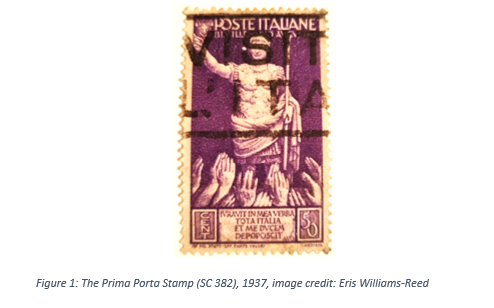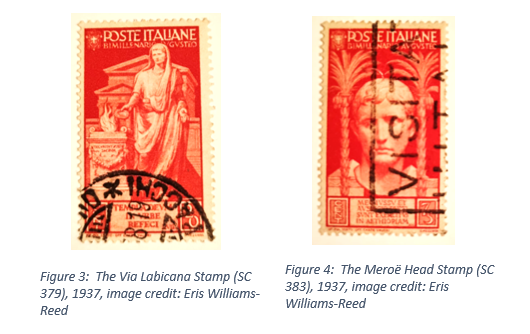An Object Within an Object - How Mussolini Used the Stamp to Appropriate Augustan Art for his Own Nefarious Means by Katie Baldwin
Stamps are something that we’ve all seen, we’ve probably all used, but rarely stop to recognise and appreciate their cultural or societal significance. Yet something as mundane as the stamp can wield a thousand stories if we look closely enough.

This blogpost explores a stamp (figure 1) issued in 1937 under the fascist Italian politician Mussolini to celebrate the bimillennial anniversary of Augustus’ birth (63 BC). The 50-cent stamp, produced as part of a wider collection, depicts the famous Prima Porta statue of Augustus (figure 2), and appeals to Mussolini’s political agenda. By engaging with the iconography of the Augustan age, scholars have argued that Mussolini sought to 'celebrate certain events in fascist history' (Follo 2013: 59) as a way of legitimizing his own fascist politics. In this post, I propose that this stamp conveys a dual narrative: it both communicates the power of a seemingly mundane object, and simultaneously communicates how modern-day objects can be used to weaponise classical culture.
This stamp offers us a starting point to think about Augustus’ influence in more recent history. In 1937, Augustus was printed on stamps across Italy as Mussolini’s way not only of commemorating the anniversary of his birth, but also thinking about Augustus’ influence on the culture and society of Italy. How did Mussolini use this image to influence modern-day Italy? To give some context as to why a collection of stamps was brought out in the first place, it is important for us to consider the political landscape of 1937 Italy, and what ties this has with Augustan Rome. 1937 marked 2000 years since the birth of Augustus, and in commemoration of this, there was an Augustan Exhibition of ‘Romanity’, set up in Italy as the 'Mostra Augustea Della Romanita'. An exhibition was set up consisting of more than 20 rooms dedicated to the history of Rome. This comes at a time when Mussolini had commissioned numerous archeological surveys and excavations across Rome and repurposed Augustan art and monuments to promote his own political agenda. Ultimately, Mussolini was trying to ally himself with Augustus, so that he was seen as a natural heir to the power of the Roman empire. So, in conclusion of your whistle stop tour of political Italy in 1937: Mussolini set up an exhibition to showcase Roman history through images of Augustus, and in doing so both celebrated Augustus and simultaneously assimilated himself with Augustus to legitimise his own power. Okay, back to the stamp...
Despite having a single purpose, this stamp can tell multiple stories about objects across both the ancient and modern worlds. On the one hand, this is a modern-day object that reflects and narrates the story of Mussolini propagating Augustus' influence and appropriating this cult image to ratify his own nefarious, fascist actions. And, on the other hand, the stamp also highlights and re-embeds the importance and achievements of Augustus through particular details of the ancient object it depicts. But what is particularly interesting is the way both of these details work together.

Figure 2: The Prima Porta statue. Image credit - https://www.flickr.com/photos/xerones/303655661
If we zoom in on the details of the stamp itself, it shows the Prima Porta statue of Augustus, the first Roman emperor, in his Roman military dress, with a collection of hands superimposed in the modern day over the bottom of the image to suggest the emperor was being celebrated. The dynamics of how Mezzana designed this stamp, with the Prima Porta image being the focal point of the stamp, and the hands of the masses lower down, suggests and depicts the power dynamics of the emperor and the people in the ancient world, and reflects of how Mussolini wanted to be respected in the modern day. On close inspection of the original statue of Prima Porta itself, we can understand that it is a monument that commemorates the emperor’s restitution of the military standards from Parthia in 20 BC. The stamp was issued as part of the year-long exhibition set up by Mussolini and a far cry from just a stamp to send a letter. This method of distributing images through 'mass communication' (Follo 2013: 55) was Mussolini appropriating Roman art and weaponising the stamps to connect his own power and political ideals to 'the bygone power and legitimacy of the Roman empire' (Bond 2018). There were many other statues printed in this collection, such as the Via Labicana (figure 3) and the Meroë head (figure 4), which could all be evidence for Mussolini weaponising the Roman insignia for his own nefarious means.

At the bottom of the Prima Porta stamp (figure 1), there is a section of Augustus’ Res Gestae itself, paraphrasing the original Latin text: 'iuravit in mea verba tota italia et me ducem depoposcit' - The whole of Italy took an oath of allegiance to me (…) and demanded that I should be the leader. By including a section of the Res Gestae on the stamp, Mussolini creates this picture in which his own actions and the actions of Augustus were fused. Mussolini is trying to ally himself with a man whom the whole of Italy (tota Italia) respected and demanded as leader (dux). By omitting the rest of the original inscription – which clarifies Augustus became leader 'for the war that I won at Actium' – Mussolini seems to be manipulating his modern audience into thinking that Italy freely elected him as leader.
I think it is evident that this stamp was not just used for sending a letter, and wasn't created for that end, but instead was piece of propaganda heavily weaponised by Mussolini to ally himself with Augustus as the bringer of peace at a time of civil unrest in Rome. Furthermore, the image of the Prima Porta statue was one of the many pieces of iconography chosen to represent the emperor as a man whose proto-fascist actions led to Roman peace. Thus, the choice of iconography of the Prima Porta was propaganda weaponised by Mussolini to present a united front from Roman leaders past and present: himself and the emperor. It is evident that this stamp holds a lot of information both about the ancient Augustan Italy and the modern Italy of 1937, whilst at face value its sole function at that time was to be used as a stamp. However, as we have seen today, delving a little deeper, tears open a whole host of political agendas and unearths a whole new meaning to the ways in which the Prima Porta is viewed.
And if a stamp can do all that in a tiny rectangle, I wonder how many (if any) other objects we see, handle and learn about from the ancient world could tell as many stories as this one...
Bibliography
Primary Sources:
Stamp-Collecting-World, 'Stamps of Italy: Commemorative of 1937', last accessed 27th July 2021, https://www.stamp-collecting-world.com/stampsofitaly_1937c.html.
Secondary Sources:
Arthurs J, (2013), 'The Totalitarian Museum: The Monstra Augustea Della Romanità' in Excavating Modernity: The Roman Past in Fascist Italy', (Ithaca, NY: Cornell University Press).
(2017), 'Bathing in the Spirit of Eternal Rome: The Monstra Augustea della Romanità' in Brill's Companion to the Classics, Fascist Italy and Nazi Germany, eds. Roche H and Demetriou K, (Leiden, The Netherlands: Brill).
Child, (2005), 'The Politics and Semiotics of the Smallest Icons of Popular Culture: Latin American Postage Stamps' in Latin American Research Review, 40.1, 108-137.
Clareborn A, (2018), 'Augusto Reframed: Exhibiting Augustus in Bimillennial Rome' in Afterlives of Augustus, AD 14-2014, ed. P Goodman, (Cambridge: Cambridge University Press).
Cooley A, (2009), Res Gestae Divi Augusti. Text, translation, and commentary.
Elsner J, (1996), 'Inventing Imperium' in Art and Text in Roman Culture, ed. J Elsner, (Cambridge: Cambridge University Press).
Squire M, (2013), 'Embodied Ambiguities on the Prima Porta Augustus' in Art History, 36.2, 242-279.
Internet Sources
ArcheoMe, (2020), 'Behind the Fascism: The Augustan Exhibition of Roman times', last accessed 26th January 2022, https://www.archeome.it/behind-the-fascism-the- augustan-exhibition-of-roman-times/.
Bond S, (2018), 'Fasces, Fascism, and How the Alt-Right Continues to Appropriate Ancient Roman Symbols', last accessed 27th July 2021, https://hyperallergic.com/459504/fasces-fascism-and-how-the-alt-right-continues- to-appropriate-ancient-roman-symbols/.
Follo V, (2013), 'The Power of Images in the Age of Mussolini', last accessed 27th July 2021, https://repository.upenn.edu/cgi/viewcontent.cgi?article=2016&context=edissertations.
Zuckerberg D, (2018), 'How the Alt-Right Is Weaponizing the Classics', last accessed 27th July 2021, https://gen.medium.com/how-the-alt-right-is-weaponizing-the-classics-d4c1c8dfcb73.
List of Illustrations
Figure 1: An image of the Prima Porta Stamp of Italy (SC 382), 1937, image credit: Eris Williams-Reed
Figure 2: The Prima Porta Statue – image credit https://www.flickr.com/photos/xerones/303655661
Figure 3: An image of the Via Labicana Stamp (SC 379), 1937, image credit: Eris Williams-Reed
Figure 4: An image of the Meroë Head Stamp (SC 383), 1937, image credit: Eris Williams-Reed
